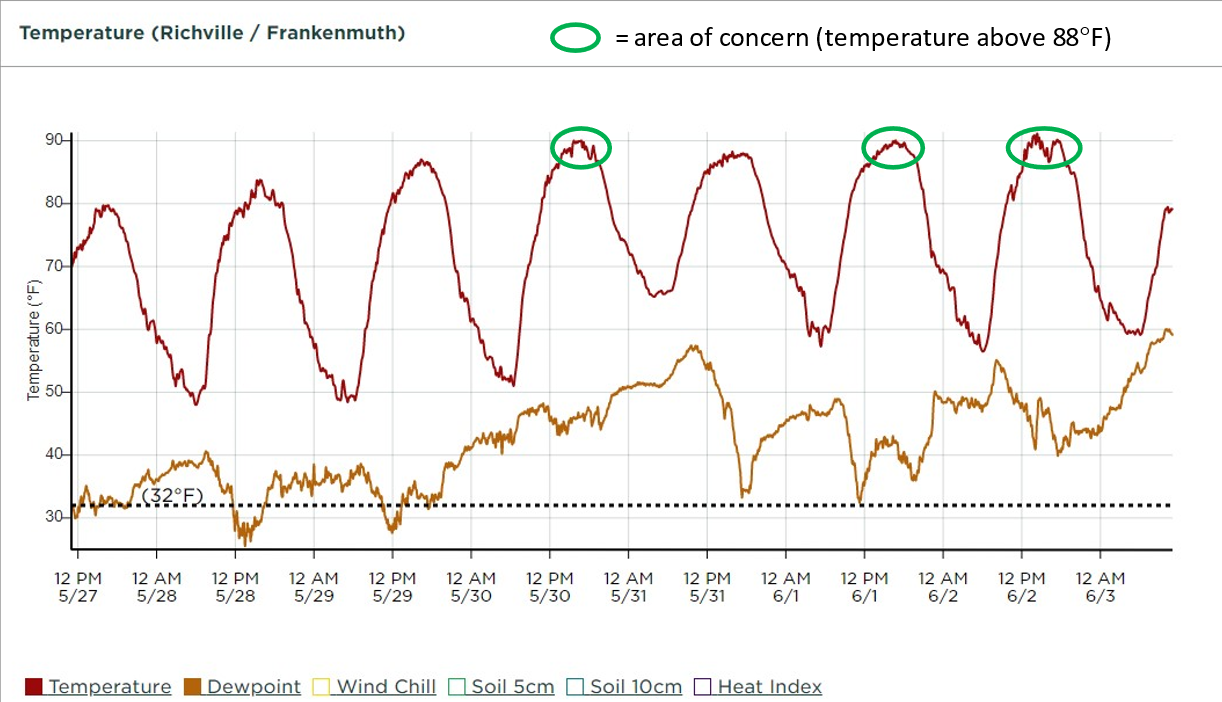Drought and high temperature impact on wheat yields in Michigan
The recent dry spell and high temperatures has growers and agronomists asking how this will impact wheat yields. Here is an overall summary of conditions and links to resources.

The extent of the dry spell and high temperatures vary by location. The first step in determining potential impact on wheat yields is to find rainfall and temperature data for your location. Growth stage is also very important. The impacts of drought and high temperatures are not the same across all growth stages. There are many great resources out there to help you assess the potential impact on your crop. Below is a summary of those resources.
Temperature
Romullo Lollato and Erick DeWolf from Kansas State University wrote a very good article describing the growth stages and impacts of high temperatures. Please take a moment to read it (“Effects of high temperatures on wheat”) so you can gain a better understanding of how heat stress impacts wheat. Here is a summary of some key points:
- The critical period is when the number of seeds per spikelet are determined; that period lasts from 20 days prior to flowering to 10 days past flowering.
- Pollen formation begins five to seven days prior to flowering and extends three days past flowering; this stage is particularly sensitive to heat stress.
- Temperatures above 88 degrees Fahrenheit can cause problems with pollen production and fertilization.
- Heat stress after flowering is complete will have less yield impact.
Drought
In many cases, much of Michigan has received an inch of rain or less in the past 30 days. Wheat uses about 0.19 inches of water per day when the temperature is 75 F. That number jumps to 0.25 inches of water when the temperature reaches 85 F. When there is a lack of rainfall, wheat must draw water from soil reserves. Less water is available in coarse textured soils. Knowing how much water your soil can provide is useful information when assessing potential water stress on wheat. More information including irrigation recommendations for wheat can be found in the Michigan State University Extension article, “Considerations for irrigating wheat.” While we are not in severe drought conditions yet, there are some areas in our region that are beginning to show signs of drought (see Figure 1).
Weather data
Go to the MSU Enviroweather website to find the weather station nearest to you. Rainfall data can be found here. Meteograms are useful depictions of weather data for the past week (see example in Figure 2). The daily high temperature is less useful in determining how much heat stress the wheat crop has undergone. Meteograms provide an average temperature for every 5-minute block of time. This allows us to track how much time the temperature was over the threshold each day. This provides a better picture of potential heat stress.
The weather stations at Richville, Sandusky and Blissfield have accumulated 1 inch of rainfall in the last month, give or take a few days. At Mount Pleasant, you have to go back 47 days to get 1 inch of accumulated rainfall. Central Michigan is in the beginning stages of drought. In terms of temperature during the week of May 27 to June 3, Richville was the hottest of the four sites accumulating 880 minutes or 14.7 hours at damaging temperatures. Mount Pleasant temperatures were similar to Richville. Blissfield was cooler with only 6.3 hours at or above 88 F and Sandusky had none.
So, to answer the question, “How much has the high temperatures impacted wheat yields?” It depends on where you are. It also matters what growth stage your wheat is at. Remember, the pollen production and fertilization (seven- to 10-day period) is the most sensitive to heat stress. See data in Table 1.
|
Table 1. Number of days it has taken to accumulate 1-inch of rainfall (top row). Amount of time temperature reached 88 F or higher for the week of May 27 through June 2, 2023 (rows 2-3). Data downloaded from MSU Enviroweather on June 3 at 11 a.m. |
||||
|---|---|---|---|---|
|
|
Richville |
Sandusky |
Mount Pleasant |
Blissfield |
|
How many days it has taken to accumulate 1 inch of rainfall? |
34 |
31 |
47 |
33 |
|
Total number of minutes (above 88 F) |
880 |
0 |
850 |
375 |

Bottom line
- There are several factors that influence the level of yield response including temperature, water availability and wheat growth stage.
- Water and heat stress can lower yield potential in wheat.
- Pollen formation and flowering occurs over a seven- to 10-day window and is the most sensitive time to temperatures above 88 F.
- Lack of rainfall or soil moisture during this time will exacerbate the problem.
- Scout your wheat crop regularly, documenting the dates and growth stage to assess potential damage to wheat yields.
- There are many resources available to help you quantify the weather and determine potential impact.



 Print
Print Email
Email


